Invented by Karen L. Van Dusen, Amazon Technologies Inc
Electronic gift certificates, also known as e-gift cards or digital gift cards, are virtual vouchers that can be purchased and redeemed online. They offer a convenient alternative to traditional paper gift certificates, eliminating the need for physical cards and allowing for instant delivery and redemption.
One of the key drivers of the market for electronic gift certificate systems is the convenience they offer to consumers. With just a few clicks, shoppers can purchase e-gift cards for their loved ones, eliminating the need to visit a physical store or worry about shipping times. This convenience factor has made e-gift cards a popular choice for last-minute gifts or for those who prefer to let the recipient choose their own gift.
Furthermore, electronic gift certificates provide a flexible and personalized gifting experience. Consumers can choose from a wide range of designs and themes, allowing them to tailor the gift to the recipient’s preferences. Additionally, many e-gift card platforms offer the option to include a personalized message, adding a personal touch to the gift.
From a business perspective, electronic gift certificates offer several advantages. Firstly, they provide a cost-effective solution for businesses looking to offer gift cards to their customers. Traditional paper gift certificates can be expensive to produce and distribute, whereas e-gift cards can be easily created and delivered electronically, reducing costs and increasing profit margins.
Moreover, electronic gift certificates can help businesses attract new customers and drive sales. By offering e-gift cards, businesses can tap into the growing trend of online shopping and reach a wider audience. Additionally, e-gift cards can act as a marketing tool, as recipients are likely to spend more than the value of the gift card when redeeming it, thus increasing the overall revenue for the business.
The market for electronic gift certificate systems is also benefiting from advancements in technology. With the increasing use of smartphones and mobile apps, consumers can now easily store and redeem their e-gift cards using their mobile devices. This mobile-friendly approach has further contributed to the popularity and growth of electronic gift certificates.
In conclusion, the market for electronic gift certificate systems is experiencing significant growth due to the convenience, flexibility, and cost-effectiveness they offer to both consumers and businesses. As e-commerce continues to thrive and online shopping becomes the norm, electronic gift certificates are likely to become an even more integral part of the gifting experience.
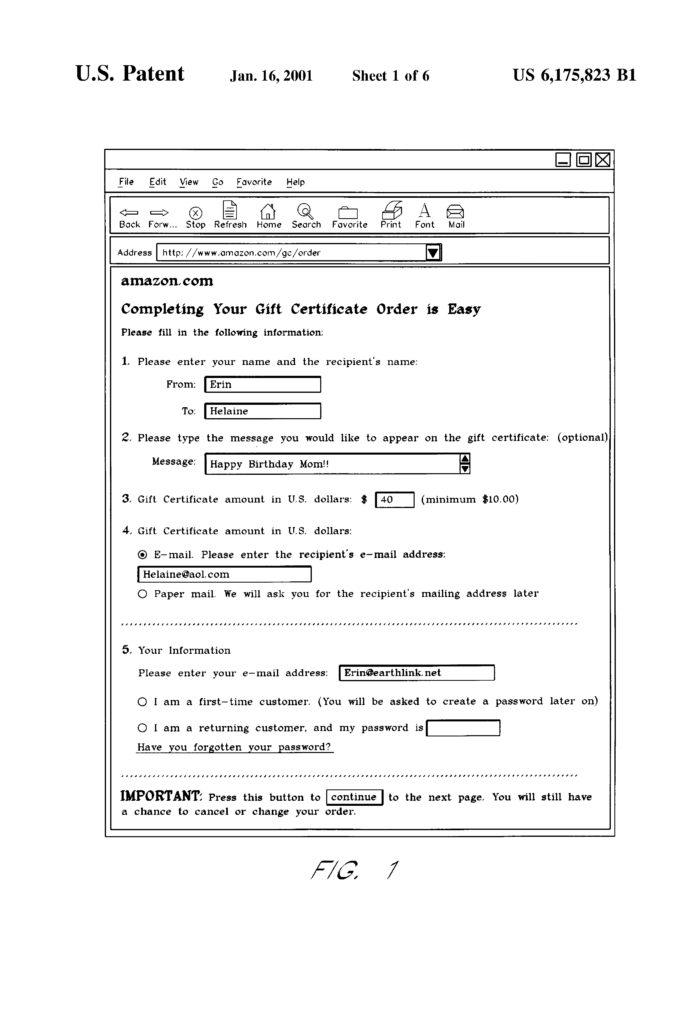
The Amazon Technologies Inc invention works as follows
An electronic certificate system” is disclosed. It distributes electronic certificates as e-mails that contain hyperlinks to automate the redemption process. The recipient of a gift card clicks on a hyperlink and his computer sends an automatic claim code to a merchant’s website. In response, the site automatically credits the recipient’s account with the amount of the gift certificate. The recipient’s balance will be automatically applied when they make a subsequent purchase on the merchant’s website.
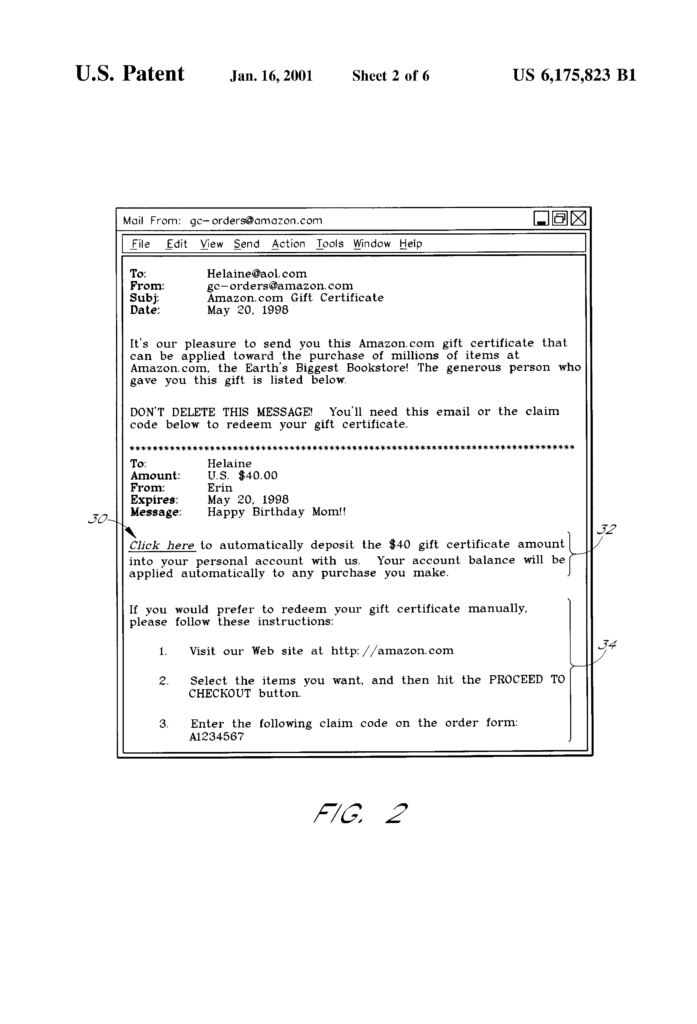
Background for Electronic Gift Certificate System
In the world of Internet commerce it is not uncommon for online merchants’ Web sites to offer functionality that allows users to buy and redeem electronic gifts certificates. In order to purchase a certificate, the purchaser will typically use a standard Web-browser to download, complete, and submit an order form for a gift card (which is usually composed of several form pages). The order form will typically ask for the following information: the name of purchaser, recipient’s name, email address, and amount of gift certificate.
The Web site will automatically send an email to the recipient in response to the order. In this e-mail, you will find the recipient’s name, the value of the gift card, a claim code for the gift voucher, and instructions on how to redeem the gift coupon. In order to redeem the gift card, the recipient must first access the merchant website and choose one or more products for purchase. The user might also be required to navigate through a redemption area. After completing a “checkout” area, the user is given the opportunity to enter and submit a gift certificate claim code. The user will be given the option to enter and submit the code for the gift certificate when they reach the?checkout?
This method of distributing electronic gift certificates and redeeming them has a number of problems. The recipient must manually enter the code. The user could forget to enter the code at the time of check-out, resulting in the gift certificate not being redeemed. If the recipient enters the claim code incorrectly, they may have to re-enter it or even receive credit for the gift certificate of another user.
The recipient must either redeem the gift certificate right away or save the claim code to use later. It may be impossible or difficult for the recipient of the gift certificate to redeem it if the claim code has been lost before use.
The present invention aims to provide an efficient and reliable method for the distribution and redemption of electronic gift certificates.
The present invention is an electronic gift certificate that improves the efficiency of redemption. According to the invention, electronic gift certificates are distributed in the form e-mails that contain hyperlinks. This automates the redemption process. The recipient of a gift card clicks on a hyperlink and their computer sends an identification code or claim code to the merchant Web site. In response, the site automatically credits the gift certificate amount into the recipient’s account. The recipient’s balance will be automatically applied when they make a subsequent purchase on the merchant’s website.
This process eliminates the need for recipients to manually enter the claim codes. The redemption process becomes easier and faster for the recipient of the gift certificate. There is also little to no risk of the user submitting an incorrect claim code.
Another benefit is that you don’t need to keep the gift certificate code on hand until the purchase. The recipient may, for example, click the link immediately after receiving the gift certificate to credit their account but delay making the purchase until later. This reduces the likelihood that a claim code is lost before a user makes a payment. The user does not need to remember to enter the claim code during the checkout process.
The term “Web site” is used throughout the description. This term is used to describe a network site accessible by users that implements basic World Wide Web Standards for the coding of hypertextual document and their transmission. These standards include HTML (the Hypertext Language) and HTTP. The term “site” should be understood. is not intended to imply a single geographic location, as a Web or other network site can, for example, include multiple geographically-distributed computer systems that are appropriately linked together.
The present invention is an electronic gift certificate that improves the efficiency of redemption. According to the invention, electronic gift certificates are distributed in the form e-mails that contain hyperlinks. This automates the redemption process. The recipient of a gift card clicks on a hyperlink and his computer sends an automatic claim code to the merchant Web site. In response, the site automatically credits the recipient’s account with the amount of the gift certificate. The recipient’s balance will be automatically applied when they make a subsequent purchase on the merchant’s website.
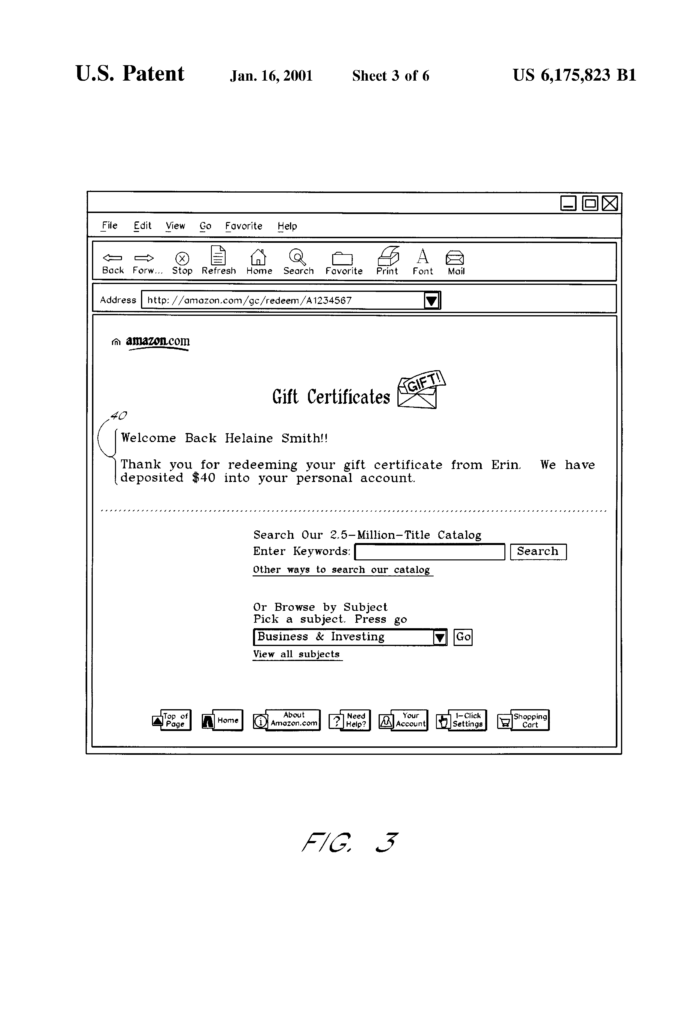
This process eliminates the need for recipients to manually enter the claim codes. The redemption process becomes easier and faster for the recipient of the gift certificate. There is also little to no risk of the user submitting an incorrect claim code.
Another benefit is that you don’t need to keep the gift certificate code on hand until the purchase. The recipient may, for example, click the link immediately after receiving the gift certificate to credit their account but delay making the purchase until later. This reduces the likelihood of the claim code being lost before it is used. The user does not need to remember to enter the claim code during the checkout process.
The following description of a preferred implementation will be made with reference to FIGS. 1-6. Throughout the following description, reference will be made to various implementation-specific details, including, for example, coding conventions, document and protocol standards, and forms used for purchasing and redeeming electronic gift certificates. These details are included to describe a preferred embodiment and not to limit scope of the invention. The appended claims define the scope of the invention.
For illustration purposes, the merchant website in the disclosed implementation will be the Web site for Amazon.com. Amazon.com is well-known in the Internet commerce field for its functionality that allows users to browse and purchase online from a catalog with over 2.5 million titles. The site has a database of accounts that stores data (names and e-mails, billing information etc.). Users who have made previous purchases on the site are listed. Other embodiments may include items that can be downloaded, such as software and digital publications.
FIG. The figure 1 shows an example of a gift certificate order page. This can be used for placing an order for a gift certificate electronically. This page may be retrieved by the user, for instance, by clicking on a link to “gift certificates” Amazon.com may provide a link to this page. As shown in FIG. The form contains fields to specify the following information.
The order form may include additional fields (not shown), which allow the buyer to specify the recipient by using something other that an e-mail, such as their name, address or phone number. This information would be used by the Web site 50 to find out the recipient’s email address, for example from a database of accounts.
After the buyer fills out this form and submits it, he or she is then presented with additional pages to complete the order (not shown). The user may be asked to enter a credit card or billing information in order to pay for the gift certificate. The Web site will send a gift voucher e-mail to the recipient (FIG. The recipient receives a gift certificate e-mail (FIG.
FIG. “FIG. The recipient will receive a gift certificate e-mail document (?e-mail?) In this example, we assume that the recipient has registered on the Amazon.com website. As shown in FIG. The e-mail contains a hyperlink 30, which allows the recipient to redeem the gift card automatically, as well as a description 32 of how the automated redemption works. The hyperlink 30 appears to the user in highlighted text. It can also be displayed as an icon, or as another graphical image.
The URL (Uniform Resource Location) associated with hyperlink 30 should include a unique gift certificate claim code. The URL can be, for example, in the form
http://amazon.com/gc/redeem/A 1234567,
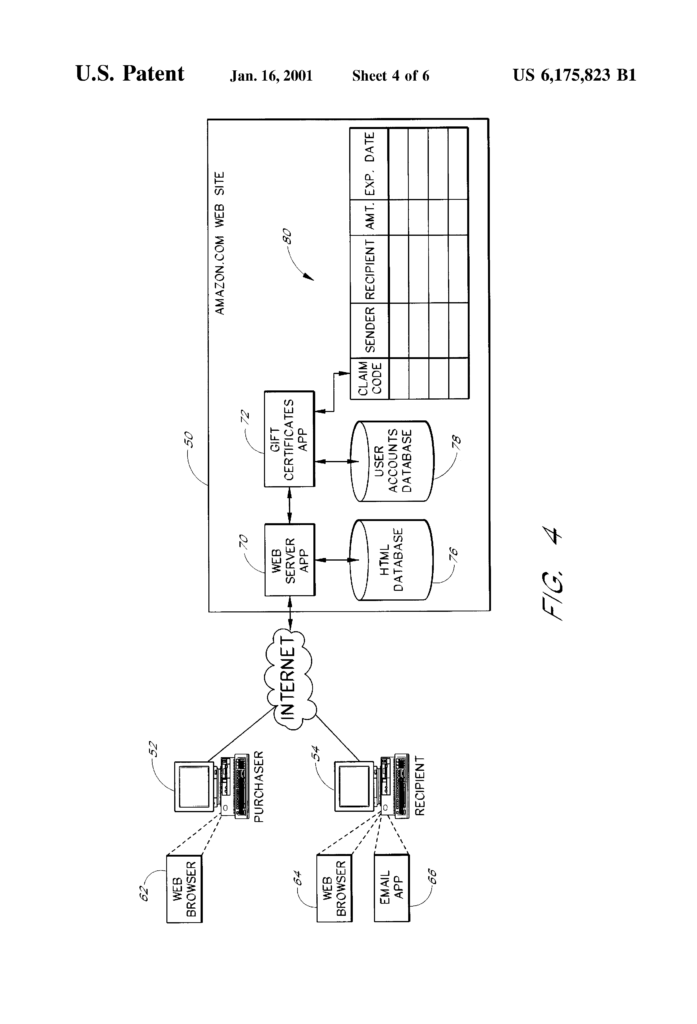
Where A1234567 represents the claim code. The recipient may select the hyperlink 30 by using any method supported by their computer. For example, they can click on the link using a mouse or touch the link using a touch-sensitive screen, or use a voice command. The claim code is sent to the website when the recipient clicks on this hyperlink 30 (as a part of the standard HTTP GET).
The site uses this information to identify the recipient and automatically credit their personal account. A sample redemption confirmation page displayed to a recipient after selecting the hyperlink 30 can be seen in FIG. “Figure 3 and discussed below.”
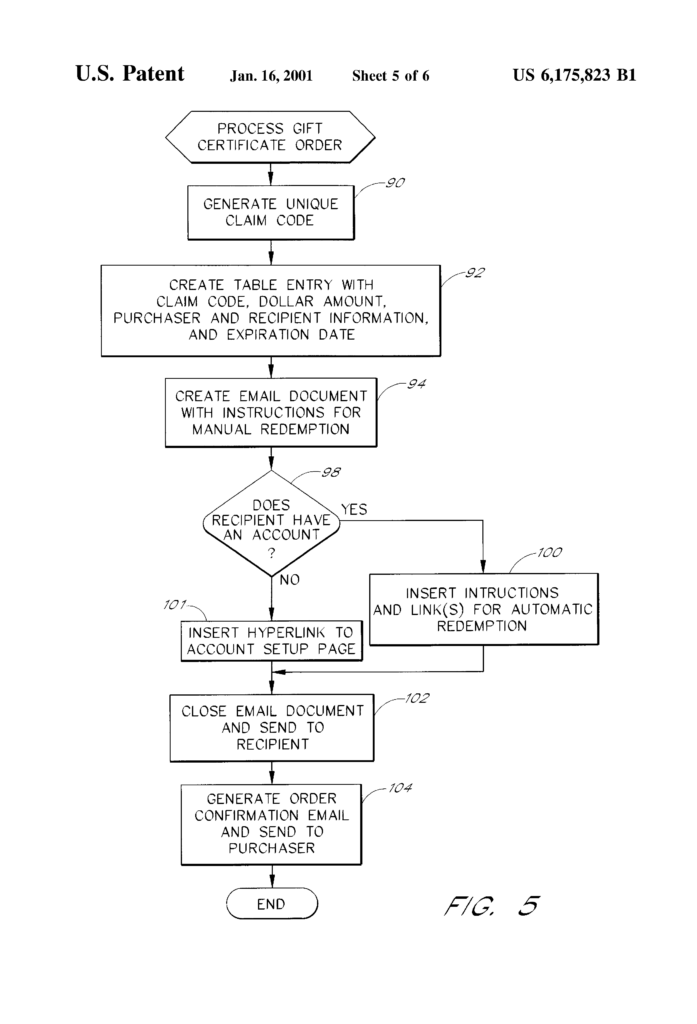
Click here to view the patent on Google Patents.
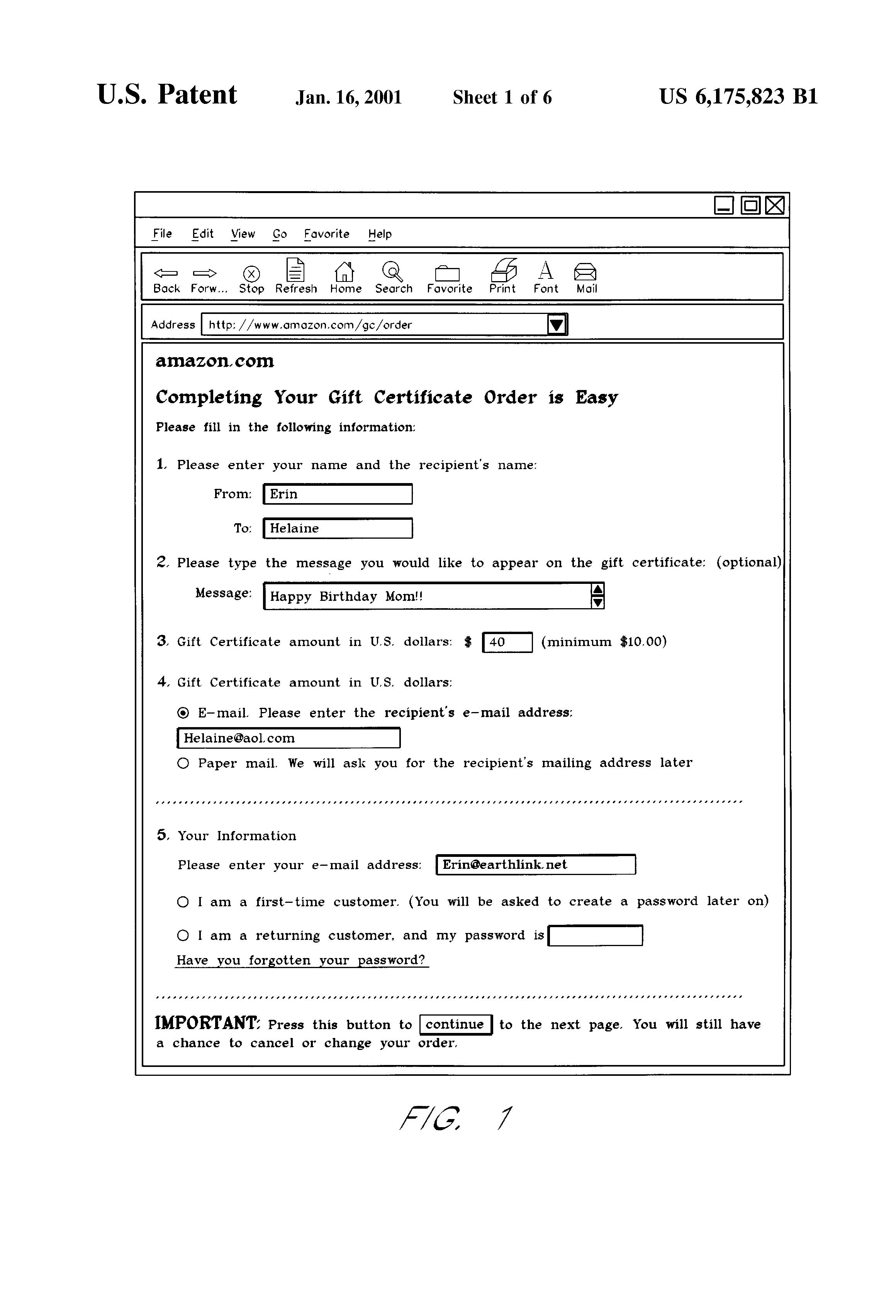
Leave a Reply